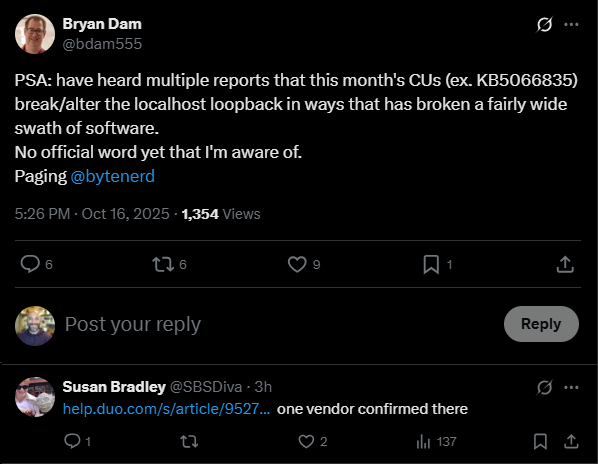This Wednesday, October 15th, I encountered an unpleasant surprise when I began connecting to Microsoft 365 services to test the latest prerelease version of Maester: I could not connect to Microsoft Teams using PowerShell!
Import-Module Maester
Connect-Maester -Service All -TenantId $MyTenantId
Connect-MicrosoftTeams: ~\Documents\PowerShell\Modules\Maester\1.3.90\public\Connect-Maester.ps1:284
Line |
284 | Connect-MicrosoftTeams > $null
| ~~~~~~~~~~~~~~~~~~~~~~~~~~~~~~
| One or more errors occurred. (An HttpListenerException occurred while listening on
| http://localhost:52723/ for the system browser to complete the login. Possible cause and
| mitigation: the app is unable to listen on the specified URL; run 'netsh http add
| iplisten 127.0.0.1' from the Admin command prompt.)
Connect-MicrosoftTeams: ~\Documents\PowerShell\Modules\Maester\1.3.90\public\Connect-Maester.ps1:284
Line |
284 | Connect-MicrosoftTeams > $null
| ~~~~~~~~~~~~~~~~~~~~~~~~~~~~~~
| An HttpListenerException occurred while listening on http://localhost:52723/ for the
| system browser to complete the login. Possible cause and mitigation: the app is unable to
| listen on the specified URL; run 'netsh http add iplisten 127.0.0.1' from the Admin
| command prompt.
Connect-MicrosoftTeams: ~\Documents\PowerShell\Modules\Maester\1.3.90\public\Connect-Maester.ps1:284
Line |
284 | Connect-MicrosoftTeams > $null
| ~~~~~~~~~~~~~~~~~~~~~~~~~~~~~~
| The request is not supported.
Connect-MicrosoftTeams: ~\Documents\PowerShell\Modules\Maester\1.3.90\public\Connect-Maester.ps1:284
Line |
284 | Connect-MicrosoftTeams > $null
| ~~~~~~~~~~~~~~~~~~~~~~~~~~~~~~
| One or more errors occurred. (An HttpListenerException occurred while listening on
| http://localhost:52723/ for the system browser to complete the login. Possible cause and
| mitigation: the app is unable to listen on the specified URL; run 'netsh http add
| iplisten 127.0.0.1' from the Admin command prompt.)
The process still opened a browser, which proceeded to show a “localhost refused to connect” error.
The timing of this felt like it may have been patch related, but I do frequently test prerelease software and it honestly could have been anything. Then I was fortunate to see a Twitter/X post from Bryan Dam and a reply from Susan Bradley that validated the theory.
That post and the Cisco Duo article 9527 that Susan Brady shared (Why is Duo Desktop not detected on my Windows device after installing updates to Windows 11?) was the confirmation that I needed. (Additional information: #2815434 on askwoody.com.)
The October 14, 2025 KB5066835 update is definitely breaking apps and authentication processes that utilize the localhost loopback listener. I removed the two updates that the Cisco Duo article mentioned, rebooted, and the issue immediately went away.
I haven’t found a publicly visible statement from Microsoft yet, but this explanation is included in the Windows release health message center:
Following installation of updates releases on or after October 14 (the Originating KBs listed above), server-side applications that rely on HTTP.sys may experience issues with incoming connections. As a result, IIS websites might fail to load, displaying a message such as “Connection reset – error (ERR_CONNECTION_RESET)”, or similar error. This includes websites hosted on http://localhost/, and other IIS connections.
Here’s one way to resolve the issue until a new security patch or hotfix is released:
Use WUSA to Remove the Patches
# Remove specific Windows Updates
$KBs = 'KB5066835', 'KB5065789'
foreach ($KB in $KBs) {
Write-Host "Attempting to uninstall $KB..."
Start-Process -FilePath "wusa.exe" -ArgumentList "/uninstall /kb:$($KB -replace 'KB','') /quiet /norestart" -Wait
}
Or simply:
wusa /uninstall kb:5066835
wusa /uninstall kb:5065789
Use DISM to Remove the Patches
# Remove updates using DISM
$KBs = 'KB5066835', 'KB5065789'
foreach ($KB in $KBs) {
Write-Host "Attempting to remove $KB using DISM..."
Start-Process -FilePath "dism.exe" -ArgumentList "/Online /Remove-Package /PackageName:$KB /Quiet /NoRestart" -Wait
}
Use the PSWindowsUpdate PowerShell Module
I used the PSWindowsUpdate PowerShell module to remove the patches:
Install-PSResource -Name PSWindowsUpdate
Remove-WindowsUpdate -KBArticleID 5066835
Remove-WindowsUpdate -KBArticleID 5065789
After uninstalling, you will need to reboot your computer.
I’m sure there are many more details to spell out and more affected applications to list, but I wanted to get this post out quickly to help others that were struggling with this issue. Please add others that you know of in the comments!
Thank you!
Sam
